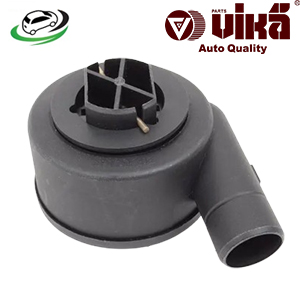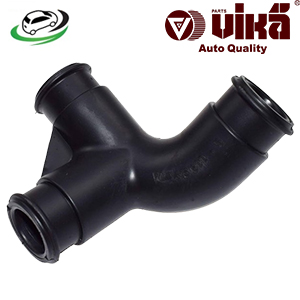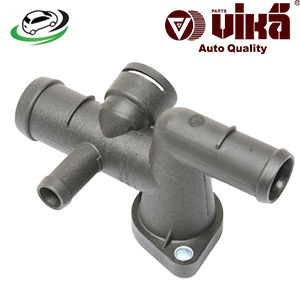-40%
Get Radiator Coolant Hose Flange VW 337/20AE 1.8T/ Golf IV 1.8T/ Jetta IV 1.8T/ Jetta IV GLI 1.8T 06A121132Q
The radiator coolant hose flange is a vital component of a vehicle’s cooling system, which is responsible for maintaining optimal engine temperature and preventing overheating. This component connects the radiator hoses to various parts of the engine, ensuring a secure and leak-free transfer of coolant. Understanding the function, importance, types, common issues, maintenance, and consequences of a malfunctioning radiator coolant hose flange is crucial for maintaining a vehicle’s cooling system and overall engine health.
Function of the Radiator Coolant Hose Flange
The radiator coolant hose flange serves several important functions within the cooling system:
- Connection Point: The flange acts as a connection point between the radiator hoses and other components of the cooling system, such as the radiator, thermostat housing, water pump, or engine block. It ensures that coolant flows smoothly between these parts, maintaining the engine’s operating temperature.
- Sealing and Prevention of Leaks: The flange is equipped with gaskets or O-rings that create a tight seal between the radiator hoses and the connecting components. This seal prevents coolant leaks, which can lead to overheating and engine damage.
- Facilitating Coolant Flow: By securely attaching the radiator hoses to their respective connections, the flange facilitates the proper flow of coolant throughout the engine and cooling system. This ensures that the engine remains at its optimal operating temperature.
- Maintaining System Pressure: The flange helps maintain the pressure within the cooling system, which is crucial for the proper functioning of the radiator and the entire cooling system. Adequate pressure ensures efficient coolant circulation and prevents the coolant from boiling or evaporating.
Importance of the Radiator Coolant Hose Flange
The radiator coolant hose flange is essential for several reasons:
- Engine Temperature Regulation: Properly functioning flanges ensure that coolant flows efficiently between the radiator and the engine. This helps regulate the engine’s temperature, preventing overheating and maintaining optimal performance.
- Preventing Coolant Leaks: A well-sealed flange prevents coolant leaks, which can lead to low coolant levels and engine overheating. Leaks can also cause damage to other engine components and lead to costly repairs.
- System Integrity: The flange contributes to the overall integrity of the cooling system. By maintaining secure connections between hoses and components, it helps ensure that the cooling system operates as intended and avoids potential failures.
- Avoiding Engine Damage: An improperly functioning flange can lead to coolant leaks, pressure loss, or poor coolant flow, which can cause engine overheating and damage. Maintaining the flange in good condition helps protect the engine and extend its lifespan.
Types of Radiator Coolant Hose Flanges
There are several types of radiator coolant hose flanges, each designed for specific applications and engine configurations:
- Metal Flanges:
- Description: Metal flanges, typically made from aluminum or steel, are durable and resistant to high temperatures and pressures.
- Function: These flanges provide a robust connection between the radiator hoses and other components. They are commonly used in high-performance or heavy-duty engines where durability is critical.
- Plastic Flanges:
- Description: Plastic flanges are lightweight and cost-effective. They are often made from high-quality polymers designed to withstand engine temperatures.
- Function: Plastic flanges are used in many modern vehicles and are typically found in less demanding applications. They are less prone to corrosion compared to metal flanges but may be more susceptible to cracking or warping.
- Flanges with Integrated Thermostats:
- Description: Some radiator coolant hose flanges come with an integrated thermostat housing. This design combines the flange and thermostat into a single unit.
- Function: This type of flange simplifies the cooling system design by combining two components into one, which can reduce the number of potential leak points and streamline maintenance.
- Custom or Specialized Flanges:
- Description: Custom or specialized flanges are designed for specific vehicles or high-performance applications. They may feature unique shapes, materials, or mounting configurations.
- Function: These flanges are tailored to meet specific requirements and provide a precise fit for custom or aftermarket cooling systems.
Common Issues with Radiator Coolant Hose Flanges
Like any automotive component, radiator coolant hose flanges can experience issues over time. Common problems include:
- Cracking or Warping: Exposure to high temperatures and pressure can cause plastic flanges to crack or warp. This can lead to coolant leaks and poor system performance.
- Corrosion: Metal flanges are susceptible to corrosion, especially if the coolant contains contaminants or if the flange is exposed to harsh conditions. Corrosion can weaken the flange and lead to leaks.
- Gasket Failure: The gaskets or O-rings used in the flange to create a seal can deteriorate over time. A failed gasket can result in coolant leaks and pressure loss.
- Loose Connections: Over time, the flange or hose connections can become loose due to vibration or improper installation. Loose connections can lead to leaks and reduced coolant flow.
- Misalignment: If the flange is not properly aligned during installation, it can cause stress on the hoses and connections, leading to leaks or damage.
Signs of a Failing Radiator Coolant Hose Flange
Recognizing the signs of a failing radiator coolant hose flange is essential for timely maintenance and preventing further issues. Common symptoms include:
- Coolant Leaks: Visible coolant leaks around the flange or hoses are a clear indication of a problem. Leaks can occur due to cracks, damaged gaskets, or loose connections.
- Overheating Engine: If the engine is overheating, it may be due to a faulty flange causing improper coolant flow or pressure loss. Overheating can lead to engine damage if not addressed promptly.
- Low Coolant Levels: A drop in coolant levels may indicate a leak at the flange or elsewhere in the cooling system. Regularly checking coolant levels can help identify potential issues early.
- Steam or Smoke: Steam or smoke coming from under the hood can be a sign of a coolant leak or overheating caused by a failing flange. This can indicate that coolant is escaping and coming into contact with hot engine parts.
- Check Engine Light: The check engine light may illuminate if the engine control unit detects issues related to the cooling system, such as a loss of coolant pressure or temperature irregularities.
Maintenance and Replacement of the Radiator Coolant Hose Flange
Proper maintenance and timely replacement of the radiator coolant hose flange are essential for ensuring the cooling system operates efficiently. Key practices include:
- Regular Inspection: Periodically inspect the flange, hoses, and connections for signs of wear, damage, or leaks. Ensure that the flange is properly sealed and secure.
- Check for Leaks: Monitor the area around the flange for coolant leaks. Address any leaks promptly to prevent overheating and engine damage.
- Replace Damaged Components: If the flange is cracked, corroded, or otherwise damaged, replace it with a new, high-quality part. Follow the manufacturer’s recommendations for replacement parts.
- Ensure Proper Installation: When installing a new flange, ensure that it is properly aligned and that all gaskets or O-rings are correctly positioned. Tighten connections to the manufacturer’s specifications to prevent leaks.
- Maintain Coolant System: Regularly check and maintain the coolant system, including coolant levels and quality. Follow the vehicle manufacturer’s maintenance schedule for coolant replacement and system checks.
Consequences of a Malfunctioning Radiator Coolant Hose Flange
A malfunctioning radiator coolant hose flange can have several negative consequences, including:
- Engine Overheating: A faulty flange can lead to coolant leaks, pressure loss, or poor coolant flow, resulting in engine overheating. Overheating can cause severe engine damage, including warped heads or a blown head gasket.
- Coolant Leaks: Leaks at the flange can result in a loss of coolant, leading to low coolant levels and potential engine damage due to insufficient cooling.
- Reduced Engine Performance: Improper coolant flow or pressure can lead to reduced engine performance, including poor acceleration and decreased power output.
- Increased Emissions: An overheating engine or coolant leaks can affect emissions control systems, leading to increased emissions and potential failure of emissions tests.
- Costly Repairs: Ignoring issues with the flange can lead to more severe engine problems and costly repairs. Timely maintenance and replacement can prevent these expenses and ensure reliable engine operation.
Follow us on Facebook for more parts.



